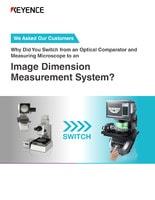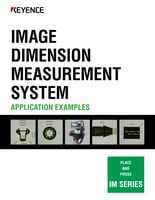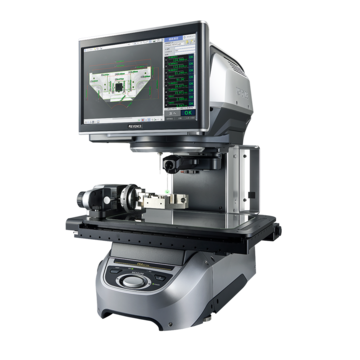Optical Comparator (Profile Projector)
What is an Optical Comparator
Wondering what an optical comparator is and how it works? Here is everything you need to know about optical comparators, from the basics of comparator measurement to the accuracy of optical comparator measurements. Discover the benefits of using optical comparators for precision measurement and explore the different types of optical comparators available.
Introduction to Optical Comparators
Patented in 1925, an optical comparator is a measuring instrument that uses a shadowed image to achieve non-contact measuring of parts. Optical comparators are known for their easy use when measuring part length, width, radii, diameters, and angles across industries like aerospace, automotive, and medical instruments.
However, as automated technology progresses and standard optical comparators stay the same, technicians are seeing limitations. The margin of error, manual adjustment, and lack of 3D feature measurement are becoming setbacks. In response, KEYENCE created image dimension measurement systems (IM) as an enhancement of a typical optical comparator. In this blog, we'll dive into the technicalities of optical comparators and how IMs fit in.
What is an Optical Comparator?
An optical comparator is a measuring device set up like a microscope, with a stage, lens, and light. It uses either a vertical or horizontal light source that projects on a part and creates a silhouette. Whether the light is shining horizontally or vertically will affect how the shadow is produced. In turn, this determines how the part is measured.
Horizontal optical comparators shine light horizontally for a side shadow of a part. These types of comparators are best for parts in a fixed location. For instance, measuring a screw attached to a part. On the other hand, vertical optical comparators shine light vertically. Vertical comparators work best for flat parts or parts that can be moved around and unattached to a larger piece.
How Does an Optical Comparator Work?
We've discussed the basics of how an optical comparator works, so now, let's dive into the comparator measuring process that takes place. First, an optical comparator captures an image of a part. The capturing could be done simply by shining the light. Or in more advanced systems, displayed on a screen. Then, measuring the XY stage and dimensions takes place. Since many optical comparators are still manual and haven't changed much since 1925, this step may be done with the human eye by a metrologist or other technician. In advanced systems, optical comparators can achieve this in seconds automatically.
Optical comparators are versatile and are used for a range of measurements like length/width, radius/diameter, and angle. With some of these methods, extra accessories like fixtures, overlay charts, and curtains need to be used.
Why Are Optical Comparators So Popular?
Optical comparators have reigned popular for so many years without change because of their measuring capabilities. The fact that optical comparators are a non-contact way of measuring is significant. Because these tools are in contact, there is no potential for damage or alterations on a sensitive part. Additionally, the non-contact method results in less human error from technicians accidentally moving the part—which frequently happens with hand gauges and other handheld tools.
Another reason why comparator measurement is widely used is because of the comparator's ability to measure the X and Y axes at the same time if needed. Handheld tools like calipers, micrometers, and height gages can only measure one axis, meaning an optical comparator helps increase measurement efficiency.
Applications of Optical Comparators
Optical comparators are used in various industries with a wide range of parts including:
| Medical industry | Automotive industry | Aerospace and Defense Industry |
|---|---|---|
|
Medical industry
|
Automotive industry
|
Aerospace and Defense Industry
|
Optical Comparator Measurement Criticism
Optical comparators are known for being easy to learn to use, but at what cost? Experienced metrologists and other technicians may be used for comparator measurement, but optical comparators have some downfalls in overall efficiency and inexperienced users.
Lack of 3D Feature Measurement
Optical comparators generally only produce 2D images. If the measurement of 3D features is necessary, frequent reorientation and remeasuring are key. Additionally, adding extra tools like calipers/micrometers and height gauges also need to be added for measuring 3D features. This process is notably tedious and takes many man-hours.
Large Margin of Error
Although measurements are generally accurate, the margin of error is too wide for tightly regulated industries. Measurement can be affected by human error or simply by different technician eyesight.
Distorted Images
Because the lens that optical comparators use is similar to a microscope, shadows are often distorted based on height. For smaller objects, the shadow is larger and vice versa. This distortion makes measuring large objects difficult and tedious.
Image Dimension Measurement Systems vs Optical Comparators
Optical comparator accuracy outperforms handheld measuring tools like rulers and hand calipers, but what outperforms a standard optical comparator that hasn't been changed in 100 years?
KEYENCE created image dimension measurement systems (IM), an upgrade to the tedious work of an optical comparator. IMs are a digitized version of an optical comparator. The IMs require two simple steps—just place and press. Instead of manually doing XY stage movement, the IM automatically detects location and orientation from anywhere the part is placed on the 300 x 200 mm stage. After the detection, the IMs measure the part in seconds and report these stats. The IMs cut down time on tedious calculating of statistical values, creating graphs, and writing long lists of measurements.
Not only do IMs significantly cut down time, but they also use a telecentric lens instead of a conventional lens. The telecentric lens eliminates the possibility of distortion with shadows, enabling consistent and accurate measurement results regardless of operator.
Moving Towards IMs
Optical comparators are well known for the non-contact, easy-to-use, and versatility of measurements. But, as precision and efficiency are increasingly sought after, converting to an automated optical comparator like KEYENCE's image dimension measurement systems is becoming necessary. KEYENCE offers a 9-system lineup of IM Series and LM Series systems that ranges from entry level to advanced capability. Each system uses "place and press" operation, meaning they only require two steps for the entire inspection process – place the part on the system and press the button to measure.
KEYENCE's IMs require no extra fees for software updates, have CAD modeling capabilities, measure in seconds, and use a telecentric lens for capturing the part image. Want to learn more about how you can cut your measuring time down from hours to seconds? Contact KEYENCE, and our knowledgeable support team will answer any questions and even walk you through a demo!
Related Downloads

We asked our customers why they switched from conventional technologies to the IM Series Instant Measurement System. See how this system adds value to any inspection process.

See common optical comparator application examples measured on the IM Series Instant Measurement System. Application examples include: turned parts, machined parts, springs, stampings, fasteners, gaskets, etc.
![IM Series Q&A: Frequently Asked Questions [Summary]](/img/asset/AS_124476_L.jpg)
FAQ about the IM Series next-generation optical comparator and how it compared to conventional technology including vernier calipers, micrometers, and optical comparators.

